| home | a-z garden elements | portfolio | in the news | how we work | articles | contact |

| our recent work |
|
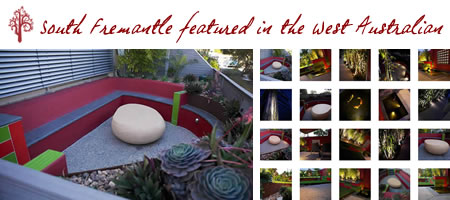 |
|
| This garden was recently featured in the West Australian New Homes Magazine. The garden was inspired by a Japanese Contemporary Aesthetic...Read more and VIEW SLIDESHOW |
|
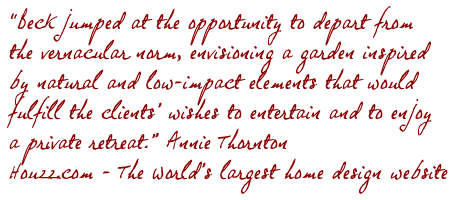 |
|
| our gardens in the news | |
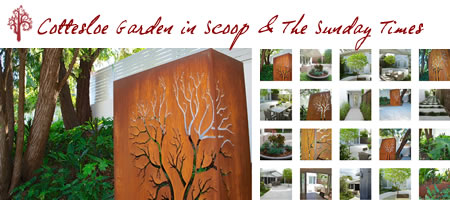 |
|
| This garden was featured in Scoop Outdoor and Garden and the Sunday Times Home Magazine.The garden design is influenced by a mixture of Mid-century design aesthetics and the use of sustainable principles…Read more and VIEW SLIDESHOW |
|
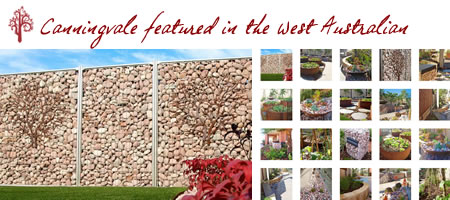 |
|
| This garden refurbishment was recently featured in the West Australian Habitat Magazine in an article by Deryn Thorpe.The brief from the client was to create a garden that would allow for them to travel…Read more and VIEW SLIDESHOW |
|
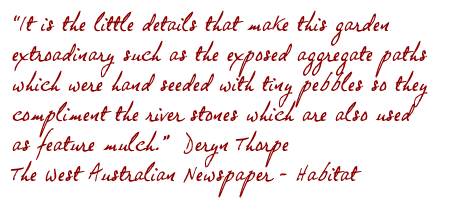 |
|
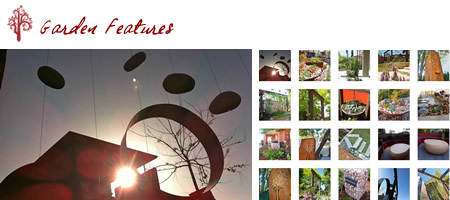 |
|
| Garden features can be anything from a garden bench to vertical garden or garden screen...Read more and VIEW SLIDESHOW | |
articles
What makes a truly sustainable garden?
The first answer to that question is simple; it must be mainly self–sustaining and planned for the long term. By this I mean it must not depend upon the continual input of large amounts of water, external energy and consumables to survive. A well-planned native garden should need only a minimum of strategic care once the initial design has been implemented and the garden has had time to establish itself.
In designing a sustainable native garden it is useful to put thought into this initial planning stage and one must also consider the longer term issues such as how the garden will function in 10, 20 or 30 years time. An example of poor planning would be the selection of a species of tree which requires constant pruning and management throughout its lifetime in order to be ‘contained’. Imagine that your garden will still be there in one hundred years time and work backwards from this point. Just getting into this mindset can be useful way weeding through short-term gardening impulse buys that will not stand the test of time. If possible go and look at fully established versions of your plant selections in your local neighbourhood or online.
In stark contrast to this way of thinking the modern trend in Perth landscaping is Backyard-Blitz style instant gardens which contain larger potted specimens of plants that require a heavy input of water initially as they have not had enough time to acclimatise to their locality. This style of garden is often poorly planned and is in many cases torn up again after 5 or 10 years because they are either inappropriately planted, water hungry or simply out-of-fashion. Such superficial cycles are to be avoided at all costs in a well-planned and planted sustainable garden.
A truly sustainable garden must mimic nature through the creation of a functioning healthy ecosystem rather than a piecemeal collection of unconnected exotic species. The key to this is careful selection of plants which thrive in local conditions and combining these plants so that they interact symbiotically.
A simple example of this would be to plant pioneering plants which grow quickly and are shade providers with slower growing understorey plants. The pioneering plants create a perfect microclimate for the understorey plants to survive and thrive.
An example of this would be the use of materials which are going to last the distance as well as endless landscaping fashion cycles.
HOUZZ FEATURE EDITORIAL ANNIE THORNON INTERVIEW WITH ANDREW BECK
Where is this garden located?
The garden is located in White Gum Valley a coastal suburb of Perth Western Australia.
What’s the square footage of the garden?
The Garden is around 300 square metres in size.
What was the garden like when you were hired?
The garden had been damaged through a home renovation that the clients had recently completed. The key existing feature in the garden was a beautiful recycled brick wall.
What did the homeowners like about the existing site and what did they want to change? What were they looking for in a garden design?
Our clients were busy professionals working from a studio at home. They were inspired by natural elements and were searching for an original and interesting design tailored for entertaining as well as incorporating private contemplative spaces to provide sanctuary within the garden. The space also needed to be suitable for the visitation of clients. They were wishing to reconnect with their garden space after an extensive period of home renovations. The clients were also conscious that, where possible, our design would have minimal impact on the environment and include local native species that would flourish with little attention. In short they wanted us to reinvent the entire space.
How did the clients hope to use the space? What features were they looking for? What did you end up keeping and what did you redesign?
The clients wished to have a space in which to entertain clients as well as friends. They also required an outdoor meditation space and were very keen on creating an outdoor shower, a small decking area and as much greenery in vertical spaces as possible. As the main surviving feature after the renovation was a red recycled brick wall we decided to punctuate this with copper vessels and fill it with a variety of plants. We also continued this theme onto the shower screen and created a couple of the sections of the garden with different types of raised vegetable gardens and dwarf fruit trees.
Is there a typical design for gardens in this area? Did what you design for this space fall in-line with this or were you stepping (a lot) outside of ordinary? What are the homes like?
The homes in this area are an eclectic mix of old and new. The typical garden in this area is a mixture of cottage gardens and native gardens. We hoped that this garden would be a slightly different take on this type of garden but representative of our own original style and sustainable in design.
Tell me about the garden screens that you use in this garden. They seem to be a feature you use in other gardens. Did you invent the design? What do they do? How do you build them? What do you grow on them? How tall are they?
Copper Planter Garden:
We love creating our own take on vertical gardens which we design and build ourselves. We believe they offer the opportunity for a touch of nature in even the most contained and urban of environments. Our mantra is that every home requires a garden space which acts as a kind of living meditative sanctuary to sustain us. In the first style of vertical gardens the copper vessels are attached to the wall in a shaded location and combine a tapestry of plants with different foliage shapes, colours and textures. Plant selections include; Dichondra Silver Falls, Variegated Bromeliads, Sedum Gold Mound, Chlorophytum Comosum (non-variegated form), Rhoeo Spathacea and Muehlenbeckia complexa.
Shower Screen:
The key elements in the shower screens are the copper vessels and the opaque backing materials which allow light and shadows to filter through and act as a kind of vertical green house. The Shower screen is situated in a more harsh microclimate and includes a whimsical and colourful selection of hardy succulents including Chalk Sticks, Sedum Jelly Beans and Crassula Erosula. The reason for choosing copper is its beautiful aging properties and the fact that it will last a lifetime. The vessels are suspended using threaded rod and bolts and curved circular fence posts all items that could be purchased off the shelf from a hardware store.
Hanging Pebble Garden:
This garden feature screens affords the possibility of creating an intimate garden space using materials and textures which the clients found inspirational. The major components of the pebble screen are the natural suspended river stone pebbles, hardwood sleepers and the three terrazzo bowls. The vines selected were an ornamental grape vine which offers autumn colour and a native wisteria ( Hardenbergia Comptoniana) vine to provide the all year round screening. The suspended bowls are filled with a selection of cascading succulents including ‘Trailing Lotus’ and ‘String of Beans’ (senecio radicans). The plants underneath the screen are a mixture of native sedges (lepidosperma gladiatum and lepidosperma longitudinale), cardboard palm and decorative potato vine. The ground covers include a selection of native violet, wide leafed myoporum parvifolium and silver dichondra..
What’s growing in this garden?
Is this a native garden? How much importance do you put on that? We believe that of the non-edible plants that are included in a garden at least 50% of them should be local natives and that we should educate ourselves to love the aesthetic of our local species and learn to plant them creatively.
What were the primary materials used?
The primary materials used were granite, limestone, copper, hardwood railway sleepers and glacial riverstones.
Can you talk a little about your inspiration for the paths/pavers;
Having lived in Japan for three years I am very much influenced by the minimalism that is so beautifully demonstrated in traditional Japanese gardens. The materials used in the first path are hexagonal concrete forms imprinted with organic forms and punctuated with circular pavers.
The second path is more geometric in design using two different shades of granite paving arranged randomly and also interspersed with circular pavers.
In both designs the more linear design is meant to be softened by the plants once they have established themselves.
Can you explain your use of sustainable water features?
In this instance the sustainable water feature is just a simple bowl suspended as part of the living screen. On this occasion we chose to add the element of water into this garden in a simple way as a bird bath. In other gardens we also attach our garden features to rainwater tanks and create aquaponic systems in which the plants are fed by waste produced by the fish.
Other sustainable features?
The main sustainable feature in this garden is the selection of low water usage natives and the use subsurface irrigation covered by wood chips allowing no evaporation of water to occur. Another sustainable aspect to the garden is the inclusion of edible garden beds both at the front and rear of the garden which provide a generous amount of edible produce throughout the year.
What was the clients’ response to the design as well as to the final product? What’s their favorite feature? Do we see a front yard redesign in the future?
The clients were very open and generous in their allowance of experimentation. The beautiful thing about the clients response to the garden renovation was how they developed a passion for gardening and how they are now out in the garden frequently and continue to manicure the garden lovingly on a daily basis. Their favourite part of the garden was the shower screen which is directly visible from the main living area and which the clients tell me still brings a smile to their face every time they look at it.
What’s your favorite feature? What do you think makes this garden special?
My favourite part of the garden is the floating pebble screen. It is beautiful to watch the pebbles slowly move in the wind and it creates a surreal sense of rocks hanging in mid air. I am very attached to this garden because it contains many surprising and hidden elements that would never be imagined when entering the house. I have always loved secret gardens.
Were there any particular constraints you faced with this garden? Any unique challenges?
More than anything the challenge of this house was being offered a blank canvas and trying to create spaces with meaningful function form and beauty that reflect the owners. I appreciate gardens which are well thought out with many sitting spaces and nooks and crannies that can be occupied at different times of the day depending on the mood and the time of the year. I believe it is preferable that every space in the garden serves a purpose and that as far as possible there is a view from every window constantly connecting us with nature.
How do you push your creativity when it comes to your projects? What inspires you and what motivates you to think outside the norm?
I naturally love trying out new ideas and experimenting with natural materials. I often come up with a particular idea and plan it in my head first then it may take a while for the idea to find its home or a client to whom I can articulate my vision well enough to inspire them to try it out. I will always try one new plant on every job to try to acquaint myself with new species as it takes a long time to get to know how a different species survives in different microclimates.
Any last thoughts
In my gardens designs I love to use a palette of beautiful natural materials and hand-made textures and combine them to create outdoor spaces with a rich tapestry of natural colour, warmth and tranquility. I still think the most beautiful thing about landscape design as an art form is that a garden never stays the same in fact it is constantly changing and that we can only control it to a point and it does the rest for itself.

| home | a-z garden elements | portfolio | in the news | how we work | articles | links | contact | © andrew beck 2009-2016 |